Gigabyte H77N-WiFi Review – First Look at Ivy Bridge with mITX
by Ian Cutress on November 6, 2012 12:00 PM EST- Posted in
- Motherboards
- Gigabyte
- H77
- mITX
Rightmark Audio Analyzer 6.2.5
In part due to reader requests, we are pleased to include Rightmark Audio Analyzer results in our benchmark suite. The premise behind Rightmark:AA is to test the input and output of the audio system to determine noise levels, range, harmonic distortion, stereo crosstalk and so forth. Rightmark:AA should indicate how well the sound system is built and isolated from electrical interference (either internally or externally). For this test we connect the Line Out to the Line In using a short six inch 3.5mm to 3.5mm high-quality jack, turn the OS volume to 100%, and run the Rightmark default test suite at 48 kHz, 96 kHz and 192 kHz. The results are given both numerical ratings and word ratings from ‘Very Poor’ to ‘Excellent’. We grade this test by assigning each of the word ratings a value from 1-6, and the final result is the sum of these ratings, and the score should end up between 8 and 48.
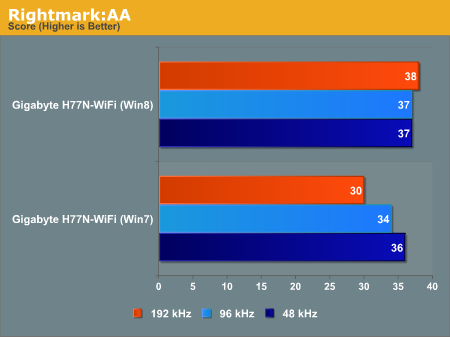
The Gigabyte board is our first motherboard on our test bed to go through Rightmark, so while we do not have any comparative numbers yet, but we can draw conclusions. In our testing, the Windows 7 performance rises with bit-rate, whereas the Windows 8 driver gives constant performance throughout. The dynamic range of the Realtek ALC892 is rated at 110 dBA ideal, but losses due to design come through – in this case the Gigabyte tops out at 86.2 dBA at 48 kHz.
USB Speed
For this benchmark, we run CrystalDiskMark to determine the ideal sequential read and write speeds for the USB port using our 240 GB OCZ Vertex3 SSD with a SATA 6 Gbps to USB 3.0 converter. Then we transfer a set size of files from the SSD to the USB drive using DiskBench, which monitors the time taken to transfer. The files transferred are a 1.52 GB set of 2867 files across 320 folders – 95% of these files are small typical website files, and the rest (90% of the size) are the videos used in the Sorenson Squeeze test.

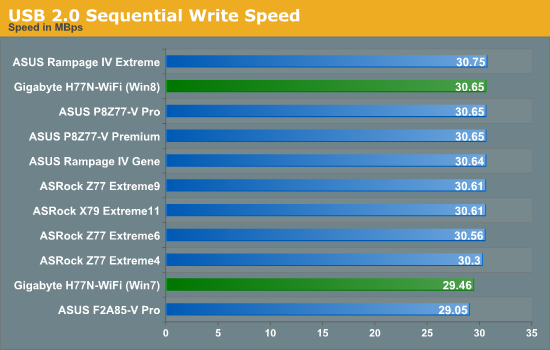
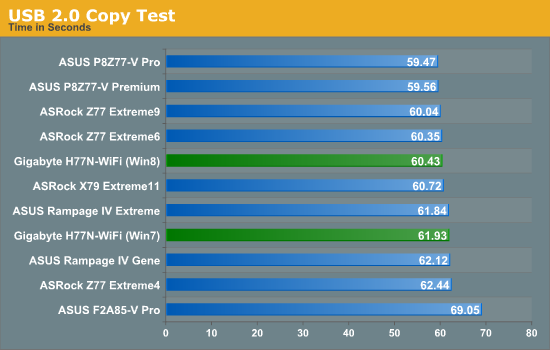

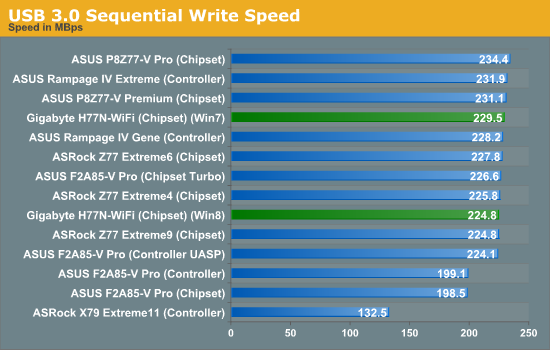

At some point in the future we will be adjusting our testing to Windows 8, which will be able to take advantage of the UASP protocol for USB 3.0 transfers. In our performance review of Windows 8 this manifested itself in an increase in sequential USB 3.0 read speed from 256.6 Mbps to 406.30 Mbps, which meant a 4% quicker USB copy test as writing was not similarly affected.
DPC Latency
Deferred Procedure Call latency is a way in which Windows handles interrupt servicing. In order to wait for a processor to acknowledge the request, the system will queue all interrupt requests by priority. Critical interrupts will be handled as soon as possible, whereas lesser priority requests, such as audio, will be further down the line. So if the audio device requires data, it will have to wait until the request is processed before the buffer is filled. If the device drivers of higher priority components in a system are poorly implemented, this can cause delays in request scheduling and process time, resulting in an empty audio buffer – this leads to characteristic audible pauses, pops and clicks. Having a bigger buffer and correctly implemented system drivers obviously helps in this regard. The DPC latency checker measures how much time is processing DPCs from driver invocation – the lower the value will result in better audio transfer at smaller buffer sizes. Results are measured in microseconds and taken as the peak latency while cycling through a series of short HD videos - under 500 microseconds usually gets the green light, but the lower the better.
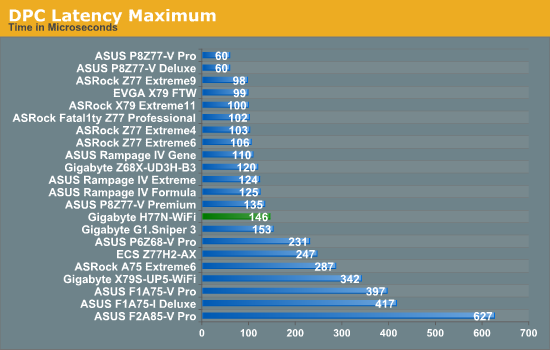
The DPC Latency test is starting to become one where we have two different types of motherboard manufacturer. The top tier manufacturers offer better software with their products, often with monitoring tools as part of the package in order to monitor overclocks or fan speeds. These monitoring tools inject high priority requests in the system on a regular basis (every 1-3 seconds), delaying other requests such as those for audio, causing spikes in DPC Latency which could lead to distortion or other audio anomalies. Surprisingly manufacturers without these tools do not have these issues. These issues are sometimes fixed via a BIOS update, but even if one board gets updated and fixed, it for some reason does not propagate to future products or the back catalogue. So here we are with the Gigabyte H77N-WiFi, which gives a good sub-200 microsecond result, but unfortunately while EasyTune6 is enabled, this can spike to 32000 microseconds. Ouch.










52 Comments
View All Comments
IanCutress - Tuesday, November 6, 2012 - link
(1) The 15 W difference between OCCT load on IGP vs. 7970 seems alright to me. As the power goes up, the efficiency should rise, so for a 55W CPU having OCCT go on full and have a system load of 65W could be a little odd, depending on how OCCT is actually loading up the pipeline.(2) My main reason for testing with a 500W Platinum is that it is the lowest wattage PSU I have in, and I plan on putting a mITX board with that PSU into a Prodigy for my own usage. There are enough users out there willing to consider a SFF build for transportation but have enough horsepower to cart to events. Stick in a 3770K + 680 GPU (or 7970, 7870), and 500W doesn't seem too far fetched. Perhaps the platinum part does a little, but it does make our power readings a little closer to the true value, especially as I run on 240V which gives a higher efficiency.
Thanks for your comments :)
Termie - Tuesday, November 6, 2012 - link
Thank YOU for your review.You know, I think I was confused by the power consumption graphs because you switched the order of OCCT and Metro2033 in the IGP and HD7970 tests. Now that you explained it, I see that it makes sense.
HappyCracker - Tuesday, November 6, 2012 - link
I own the Z77 version of this board and it slid into my ISK nicely and seems to be the same basic layout as the Intel DH57JG it replaced.Here's what's confusing about this review. It's a review of the board, but in the computation and gaming benchmarks, is the only instance of a Core i3. I would probably like to see the same processor in each of those boards to show how they'd stack up for a potential buyer. Otherwise, what I see here, is a comparison of an i3 against i5s and i7s, which should belong in a CPU review and not a board review.
Or did I miss the methodology altogether?
IanCutress - Tuesday, November 6, 2012 - link
Our future Z77 mITX testing will be on the i3, but the main comparison point here in the CPU tests is the A10 which is at a similar price point. Stay tuned for the other mITX reviews :)Ian
Scotttnz - Tuesday, November 6, 2012 - link
I bought this board for my home esxi server. I chose this one due to it's reasonable price and for the dual on board NICs to give me internal and external connectivity for my firewall/ UTM vm. Esxi 5.1 installed fine to a micro USB key, and everything works well without any fiddling around injecting drivers etc. this leaves the pic-e slot free to add a RAID card or what ever.capeconsultant - Tuesday, November 6, 2012 - link
I am interested in building a mac mini type computer. Small, quiet and fast. Any ideas? Thanks!Gigaplex - Tuesday, November 6, 2012 - link
You're not going to get as small as a Mac Mini using mini-ITX. The Mini uses laptop grade parts with a custom motherboard designed around the case. If you want something Mini-like, just put Windows on the Mac Mini, or you're going to have to settle for the larger, more powerful mini-ITX systems - something like the Antec ISK 110 VESA is a good starting point if you're aiming for as small as you can get.http://www.anandtech.com/show/6192/antec-isk-110-v...
capeconsultant - Tuesday, November 6, 2012 - link
Thank you! I am this close to Windows on a mini, just exploring last minute ideas. Thanks for the advice. I am going to Google that case now just to learn. I have researched heavily the mac mini and think that will be prefect for me.MadMan007 - Tuesday, November 6, 2012 - link
The Z77 version is only $10 more on Newegg, so I don't see a reason not to get the Z77. At the very least it gives higher memory speed options which can help with the CPU integrated graphics.EnzoFX - Tuesday, November 6, 2012 - link
This has been intel's standard for like 3 years. People should stop pointing it out as strange, and cases/heatsinks can easily take it into account.